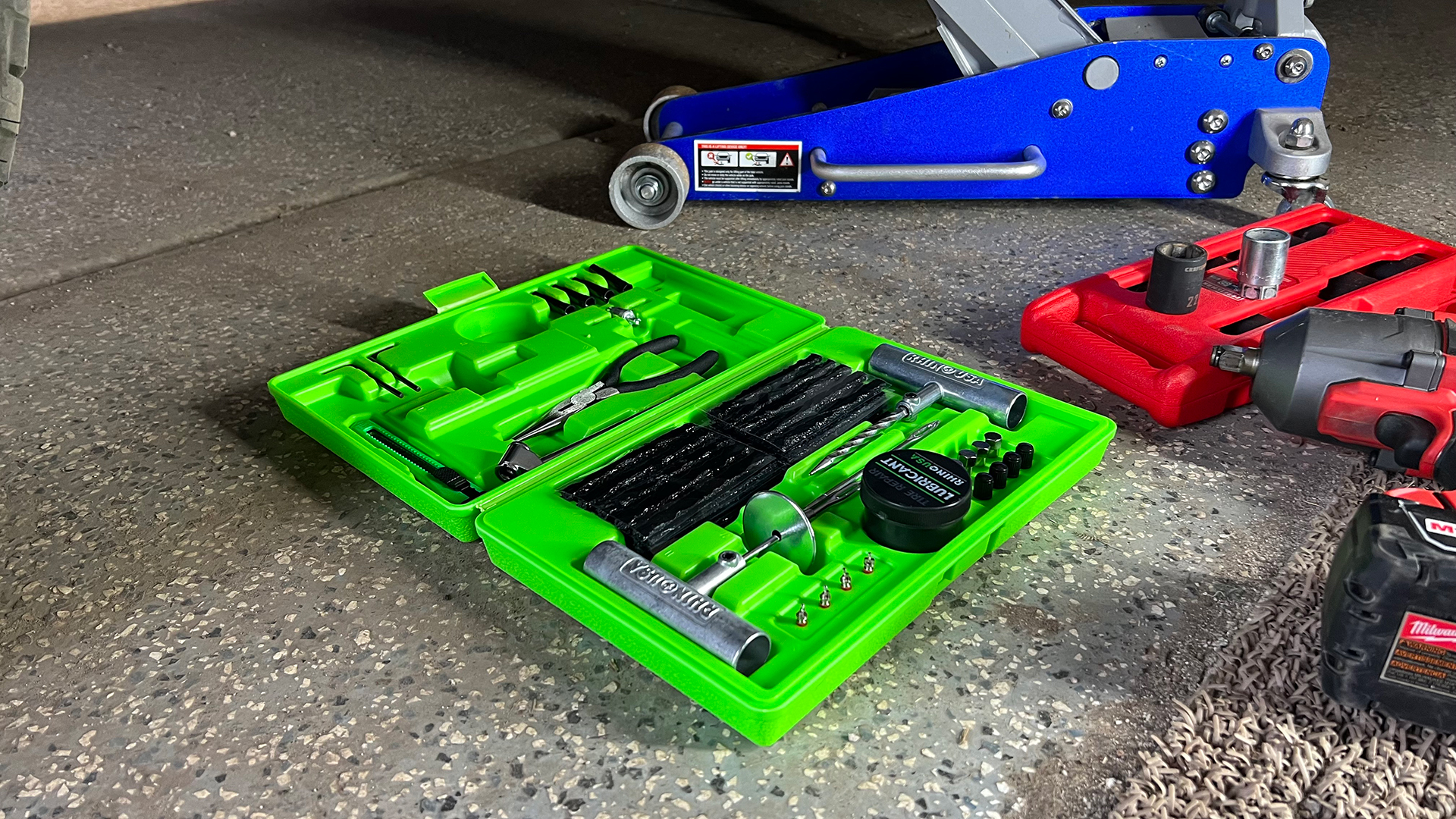

We may earn revenue from the products available on this page and participate in affiliate programs. Learn more ›
Whether you experience it in a garage, driveway, or car park, seeing a flat tire always feels the same. There’s a brief glimmer of hope when you think it’s not that bad, and maybe some air has just escaped, but once you take a closer look at the limp rubber laying flat against the ground, there’s an unescapable acceptance that you have a problem.
If a rogue nail or something of similarly sized did the damage, then you’re in luck because it can be easily fixed with a tire plug, and The Drive’s crack informational team is here to tell you exactly how to do it.
What Is a Tire Plug?
A tire plug is a cheap, easy, and reliable way to fix a tire that’s picked up a puncture. You don’t need to be a mechanic to use it and it can get you out of a sticky situation in just a few minutes.
Plugging a Tire Safety
Working on your car can be dangerous and messy, so here’s exactly what you’ll need to ensure you don’t die, get maimed, or lose a finger and that you keep your jeans, shirt, and skin spotless—hopefully. Thankfully, plugging a car tire isn’t inherently dangerous so you won’t need much in the way of protection.
Everything You’ll Need To Plug a Car Tire
We’re not psychic, nor are we snooping through your toolbox or garage, so here’s exactly what you’ll need to get the job done.
Tool List
- Car tire plug kit
- Car jack
- Jack stand
- Lug wrench
- Tire inflator
- Utility knife and pliers (if not included in the plug kit)
- Mixing bucket
- Liquid soap
- Water
Here’s How To Plug a Leaky Tire
Let’s do this!
- Use your jack to lift the car and place a jack stand on the corner where you have a flat tire.
- Remove the tire using your lug wrench.
- Mix water and some liquid soap in a bucket.
- Use your tire inflator to pump up the tire if it’s flat.
- Pour the soapy water (use a spray bottle if you have one) over the tire and look to see where air bubbles are forming: this is where you’ll find your leak.
- Remove the object causing the leak with your pliers.
- Move the spiral reaming tool (included in the kit) up and down in the hole to enlarge, roughen, and clean it.
- Lubricate the plug or apply rubber cement to it (kit dependent) and then slide it through the tire plug tool, so there’s an even length of material on both sides.
- Push the plug tool almost three-quarters of the way into the hole, then slightly twist and quickly pull the plug tool out with force, leaving behind the plug.
- If your kit requires rubber cement, leave the tire sitting for at least five minutes for it to set.
- Inflate your tire to its correct PSI and cover the plugged hole with some soapy water to ensure it’s air-tight.
- If no air is escaping, cut the ends off the plug using your utility knife.
Are Tire Plugs a Permanent Fix?
Although tire plugs can last for several years, tire manufacturers and the US DOT don’t consider tire plugs to be a permanent fix. So, it’s recommended that you only use one for as long as it takes to get a permanent repair.
Pro Tips to Plugging a Leaky Tire
- You don’t necessarily need to take the wheel off before performing the repair. So, if you don’t have a lug wrench, you can still plug your leaky tire by spinning it: this is easier if you’re repairing one of the front wheels, as you can turn them outwards.
- If your tire is punctured by a screw, it might be easier to remove it with a screwdriver rather than a pair of pliers.
- When removing the item that caused the puncture, try to take it out as straight as possible.
- Plugs should only be used when the hole is around the center of the tire. If the hole is on the shoulder or sidewall, using a tire plug kit is not the answer.
- Before inserting the plug, make sure the hole isn’t too big for the plug to fill it.
- Take your vehicle out for a quick drive once you’ve reattached the tire, and then check its PSI when you arrive home. Check the tire’s PSI again in the morning to make sure the seal is air-tight.
- If possible, take your vehicle for a drive on the highway for its first ride with a plug – this will help mold the excess plug material to the shape of your tire. Only do this if you’re sure that the plug has formed an air-tight seal.
Video
Check out the video from Erick The Car Guy below. He follows the instructions given here to the letter and adds some helpful hints and pieces of advice that he’s picked up over the many years he’s spent working as a mechanic.
